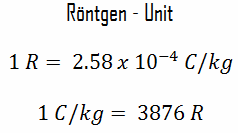Radiation exposure is a measure of the ionization of air due to ionizing radiation from high-energy photons (i.e. X-rays and gamma rays). Radiation exposure is defined as the sum of electrical charges (∆q) on all the ions of one sign produced in air when all the electrons, liberated by photons in a volume of air whose mass is ∆m, are completely stopped in air.
Radiation exposure is given the symbol X. The SI unit of radiation exposure is the coulomb per kilogram (C/kg), but in practice, the roentgen is used.
Unit of Radiation Exposure
The roentgen, abbreviated R, is the unit of radiation exposure. In the original definition 1 R means the amount of X-rays or γ-radiation that is required to liberate positive and negative charges of one electrostatic unit of charge (esu) in 1 cm³ of dry air at standard temperature and pressure (STP). Note that, 1 esu ≈ 3.33564×10−10 C. As a result, one roentgen corresponds to 2.58 x 10-4 coulomb per kg of ions generated in air and an exposure of one coulomb per kilogram is equivalent to 3876 roentgens.
Radiation exposures measured in industry (except nuclear medicine) often have comparable doses to one roentgen and the following multiples are often used:
1 mR (milli roentgen) = 1E-3 R
1 kR (kilo roentgen) = 1E3 R
To calculate the radiation dose (in Gy) from a radiation exposure of 1 R depends on the energy of the X-rays or γ-rays and the composition of the irradiated material. For example, if soft tissue is exposed to γ-rays of 1 R, the radiation dose will be approximately 9.3 milligray (mGy).
Conversion: Exposure to Absorbed Dose
Dose is defined as the amount of energy deposited by ionizing radiation in a substance. For a given radiation field, the absorbed dose will depend on the type of matter which absorbs the radiation. Although a large number of possible interactions are known, there are three key interaction mechanisms of gamma rays with matter.
For instance, for an exposure of 1 roentgen by gamma rays with an energy of 1 MeV, the dose in air will be 0.876 rad. This can be determined using the ionization energy of dry air at 20 °C and 101.325 kPa of pressure, which is 33.97 J/C. Therefore, an exposure of 2.58×10−4 C/kg (1 roentgen) would deposit an absorbed dose of 8.76×10−3 J/kg (0.876 rad) in dry air at those conditions. A table giving the exposure to dose conversion for various materials for a variety of gamma ray energies can be found in literature.
Radiation Exposure Rate
The radiation exposure rate is the rate at which an exposure is received. It is a measure of exposure intensity (or strength). The exposure rate is therefore defined as:
In conventional units, it is measured in mR/sec or R/hr. Since the amount of radiation exposure depends directly (linearly) on the time people spend near the source of radiation, the exposure is equal to the strength of the radiation field (exposure rate) multiplied by the length of time spent in that field. It must be emphasized that this concept applies only to X-rays or γ-rays in air at a point outside a body. Radiation exposure is not applicable to describe neutrons, charged particles or all interactions taking place within a body.
We hope, this article, Radiation Exposure, helps you. If so, give us a like in the sidebar. Main purpose of this website is to help the public to learn some interesting and important information about radiation and dosimeters.


